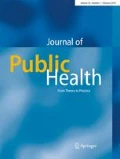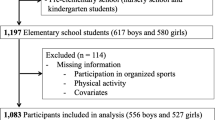Abstract
Aim
A substantial proportion of children’s and adolescent’s physical activity takes place in organised sports clubs in Germany. The purpose of this study was to describe (1) the proportion of children and adolescents who are members of sports clubs and the amount of moderate to vigorous physical activity (MVPA) performed in these clubs, and to identify socio-demographic predictors of (2) membership and (3) the amount of MVPA in sports clubs in Germany.
Subjects and methods
The sample consisted of 4,529 boys (50.5 %) and girls (49.5 %) aged between 4 and 17 years (M = 11.3; SD = 4.1). MVPA was assessed by a questionnaire. Socioeconomic status, immigration background, and residential area were assessed using a parent questionnaire.
Results
52.0 % of the girls and 63.1 % of the boys were members in sports clubs who exercised on average for 4 h per week with moderate to high intensity. The logistic regression analyses showed that gender, socioeconomic status, migration background and residential area were significant predictors of membership in sports clubs. The amount of MVPA was only significantly predicted by age, gender and residential area.
Conclusion
The results of this study imply that sports clubs have a high potential for implementation of strategies to increase general levels of physical activity.
Similar content being viewed by others
References
Baur J, Burrmann U (2000) Unerforschtes Land: Jugendsport in ländlichen Regionen [Unexplored country: youth sports in rural regions]. Meyer & Meyer, Aachen, Germany
Bös K (2009) Motorik-Modul: Eine Studie zur motorischen Leistungsfähigkeit und körperlich-sportlichen Aktivität von Kindern und Jugendlichen in Deutschland. Abschlussbericht zum Forschungsprojekt [Motorik-modul: a study on motor abilities und physical activity of children and adolescents in Germany. Final report of the research project.]. Nomos, Baden-Baden, Germany
Bouchard C, Blair SN, Haskell WL (2012) Physical activity and health. Human Kinetics, Champaign, IL
Brettschneider W (2001) Effects of sport club activities on adolescent development in Germany. Eur J Sport Sci 1(2):1–11. doi:10.1080/17461390100071201
Breuer C, Wicker P (2009) Die Situation der Sportvereine in Deutschland: ein Überblick. In: Breuer C (ed) Sportentwicklungsbericht 2007/2008: Analyse zur Situation der Sportvereine in Deutschland. Sportverlag Strauß, Köln, Germany, pp 26–48
Dobbinson SJ, Hayman JA, Livingston PM (2006) Prevalence of health promotion policies in sports clubs in Victoria, Australia. Health Promot Int 21(2):121–129. doi:10.1093/heapro/dak001
Fernandes RA, Reichert FF, Monteiro HL, Freitas Júnior IF, Cardoso JR, Ronque ERV, de Oliveira AR (2012) Characteristics of family nucleus as correlates of regular participation in sports among adolescents. Int J Public Health 57(2):431–435. doi:10.1007/s00038-010-0207-7
Gracia-Marco L, Tomas C, Vicente-Rodriguez G, Jimenez-Pavon D, Rey-Lopez JP, Ortega FB, Lanza-Saiz R, Moreno LA (2010) Extra-curricular participation in sports and socio-demographic factors in Spanish adolescents: the AVENA Study. J Sports Sci 28(13):1383–1389. doi:10.1080/02640414.2010.510846
Heinemann K (1999) Sports clubs in Europe. In: Heinemann K (ed) Sport clubs in various European countries. Schattauer, Schorndorf, Germany, pp 13–32
Jekauc D, Reimers AK, Wagner MO, Woll A (2012) Prevalence and socio-demographic correlates of the compliance with the physical activity guidelines in children and adolescents in Germany. BMC Publ Health 12(1):714. doi:10.1186/1471-2458-12-714
Jekauc D, Wagner MO, Kahlert D, Woll A (2013) Reliabilität und Validität des MoMo-Aktivitätsfragebogens für Jugendliche (MoMo-AFB) [Reliability and validity of MoMo-physical-activity-questionnaire for adolescents (MoMo-AFB)]. Diagnostica 59(2):1–12. doi:10.1025/0012-1924/a000083
Kamtsiuris P, Lange M, Schaffrath Rosario A (2007) Der Kinder-und Jugendgesundheitssurvey (KiGGS): Stichprobendesign, Response und Nonresponse-Analyse [The German Health Interview and Examination Survey for Children and Adolescents (KiGGS): sample design, response and nonresponse analysis]. Bundesgesundheitsbla Gesundheitsforsch Gesundheitsschutz 50(5–6):547–556. doi:10.1007/s00103-007-0215-9
Kimm SYS, Glynn NW, Kriska AM, Barton BA, Kronsberg SS, Daniels SR, Crawford PB, Sabry ZI, Liu K (2002) Decline in physical activity in black girls and white girls during adolescence. N Engl J Med 347(10):709–715. doi:10.1056/NEJMoa003277
Kokko S, Kannas L, Villberg J (2009) Health promotion profile of youth sports clubs in Finland: club officials’ and coaches’ perceptions. Health Promot Int 24(1):26–35. doi:10.1093/heapro/dan040
Kurth BM (2007) Der Kinder- und Jugendgesundheitssurvey (KiGGS): ein Überblick über Planung, Durchführung und Ergebnisse unter Berücksichtigung von Aspekten eines Qualitätsmanagements [The German Health Interview and Examination Survey for Children and Adolescents (KiGGS): an overview of its planning, implementation and results taking into account aspects of quality management]. Bundesgesundheitsbla Gesundheitsforsch Gesundheitsschutz 50(5–6):533–546. doi:10.1007/s00103-007-0214-x
Kurth BM, Kamtsiuris P, Holling H, Schlaud M, Dolle R, Ellert U, Kahl H, Knopf H, Lange M, Mensink GB, Neuhauser H, Rosario AS, Scheidt-Nave C, Schenk L, Schlack R, Stolzenberg H, Thamm M, Thierfelder W, Wolf U (2008) The challenge of comprehensively mapping children’s health in a nation-wide health survey: design of the German KiGGS-Study. BMC Publ Health 8:196. doi:10.1186/1471-2458-8-196
La Torre G, Masala D, De Vito E, Langiano E, Capelli G, Ricciardi W (2006) Extra-curricular physical activity and socioeconomic status in Italian adolescents. BMC Publ Health 6(1):22. doi:10.1186/1471-2458-6-22
Michaud P, Narring F, Cauderay M, Cavadini C (1999) Sports activity, physical activity and fitness of 9- to 19-year-old teenagers in the canton of Vaud (Switzerland). Schweiz Med Wochenschr 129(18):691–699
Pate RR, Trost SG, Levin S, Dowda M (2000) Sports participation and health-related behaviors among US youth. Arch Pediatr Adolesc Med 154(9):904–911. doi:10.1001/archpedi.154.9.904
Pitsavos C, Panagiotakos D, Lentzas Y, Stefanadis C (2005) Epidemiology of leisure-time physical activity in socio-demographic, lifestyle and psychological characteristics of men and women in Greece: the ATTICA study. BMC Publ Health 5(1):37. doi:10.1186/1471-2458-5-37
Rowland TW (1999) Adolescence: a “risk factor” for physical inactivity. President’s Council Physical Fitness Sports Res Digest 3(6):1–8
Seabra AF, Mendonça DM, Thomis MA, Malina RM, Maia JA (2007) Sports participation among Portuguese youth 10 to 18 years. J Phys Act Health 4(4):370–380
Strong WB, Malina RM, Blimkie CJR, Daniels SR, Dishman RK, Gutin B, Hergenroeder AC, Must A, Nixon PA, Pivarnik JM (2005) Evidence based physical activity for school-age youth. J Pediatr 146(6):732–737. doi:10.1016/j.jpeds.2005.01.055
Telama R, Yang X (2000) Decline of physical activity from youth to young adulthood in Finland. Med Sci Sports Exerc 32(9):1617–1622. doi:10.1097/00005768-200009000-00015
Telama R, Yang X, Viikari J, Välimäki I, Wanne O, Raitakari O (2005) Physical activity from childhood to adulthood: a 21-year tracking study. Am J Prev Med 28(3):267–273. doi:10.1016/j.amepre.2004.12.003
Van der Horst K, Paw M, Twisk JWR, Van Mechelen W (2007) A brief review on correlates of physical activity and sedentariness in youth. Med Sci Sports Exerc 39(8):1241–1250. doi:10.1249/mss.0b013e318059bf35
Vilhjalmsson R, Kristjansdottir G (2003) Gender differences in physical activity in older children and adolescents: the central role of organized sport. Soc Sci Med 56(2):363–374. doi:10.1016/S0277-9536(02)00042-4
WHO (2010) Global recommendations on physical activity for health. World Health Organisation, Geneva
Winkler J, Stolzenberg H (1999) Der sozialschichtindex im bundes-gesundheitssurvey [Social class index in the federal health survey]. Gesundheitswesen 61:S178–183
Woll A, Kurth BM, Opper E, Worth A, Bos K (2011) The “Motorik-Modul” (MoMo): physical fitness and physical activity in German children and adolescents. Eur J Pediatr 170(9):1129–1142. doi:10.1007/s00431-010-1391-4
Acknowledgements
This study was funded by a project grant from the German Bundesministerium für Bildung und Forschung (Federal Ministry of Education and Research) and by the German Bundesministerium für Gesundheit (Federal Ministry of Health). We thank all the adolescents who participated in this study. We would also like to express our appreciation to PD Dr. Annegret Mündermann (University of Konstanz) and Dr. Stefanie Everke Buchanan (Zeppelin University Friedrichshafen/University of Konstanz) for their writing assistance on behalf of the authors. The second author thanks the Ministry of Science of the German State of Baden-Württemberg for supporting this project through a grant scholarship of the Brigitte Schlieben-Lange-Programm.
Conflicts of interest
The authors declare that they have no conflict of interest.
Author information
Authors and Affiliations
Corresponding author
Rights and permissions
About this article
Cite this article
Jekauc, D., Reimers, A.K., Wagner, M.O. et al. Physical activity in sports clubs of children and adolescents in Germany: results from a nationwide representative survey. J Public Health 21, 505–513 (2013). https://doi.org/10.1007/s10389-013-0579-2
Received:
Accepted:
Published:
Issue Date:
DOI: https://doi.org/10.1007/s10389-013-0579-2




